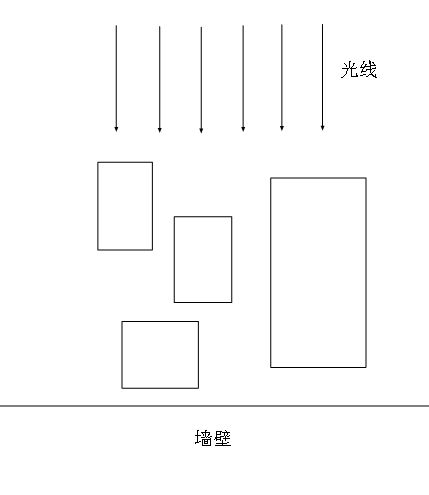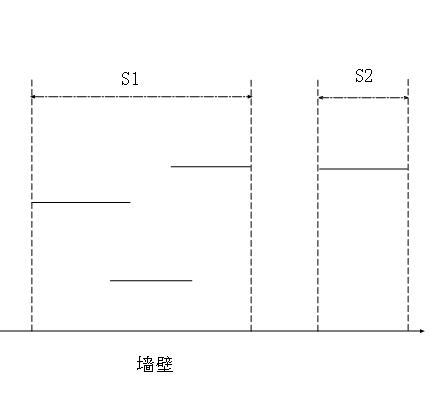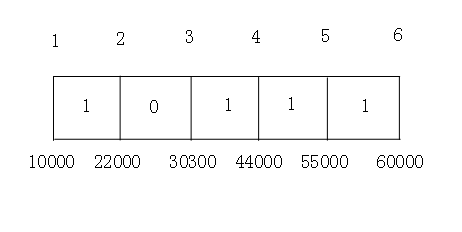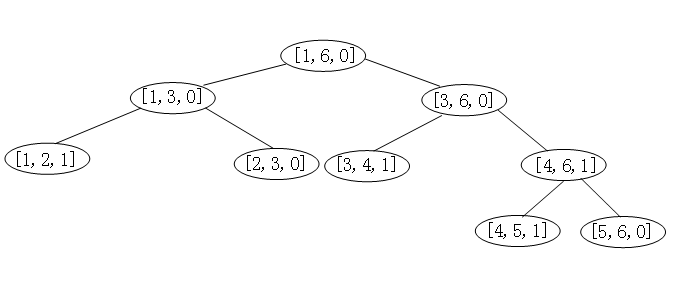线段树及其应用
线段树(segment tree)
线段树在一些acm题目中经常见到,这种数据结构主要应用在计算几何和地理信息系统中。下图就为一个线段树:
(PS:可能你见过线段树的不同表示方式,但是都大同小异,根据自己的需要来建就行。)
1.线段树基本性质和操作
线段树是一棵二叉树,记为T(a, b),参数a,b表示区间[a,b],其中b-a称为区间的长度,记为L。
线段树T(a,b)也可递归定义为:
若L>1 : [a, (a+b) div 2]为 T的左儿子; [(a+b) div 2,b]为T 的右儿子。 若L=1 : T为叶子节点。
线段树中的结点一般采取如下数据结构:
struct Node { int left,right; //区间左右值 Node *leftchild; Node *rightchild; };
线段树的建立:
Node *build(int l , int r ) //建立二叉树 { Node *root = new Node; root->left = l; root->right = r; //设置结点区间 root->leftchild = NULL; root->rightchild = NULL; if ( l +1< r ) { int mid = (r+l) >>1; root->leftchild = build ( l , mid ) ; root->rightchild = build ( mid , r) ; } return root; }
线段树中的线段插入和删除:
增加一个cover的域来计算一条线段被覆盖的次数,因此在建立二叉树的时候应顺便把cover置0。
插入一条线段[c,d]:
void Insert(int c, int d , Node *root ) { if(c<= root->left&&d>= root->right) root-> cover++; else { if(c < (root->left+ root->right)/2 ) Insert (c,d, root->leftchild ); if(d > (root->left+ root->right)/2 ) Insert (c,d, root->rightchild ); } }
删除一条线段[c,d]:
void Delete (int c , int d , Node *root ) { if(c<= root->left&&d>= root->right) root-> cover= root-> cover-1; else { if(c < (root->left+ root->right)/2 ) Delete ( c,d, root->leftchild ); if(d > (root->left+ root->right)/2 ) Delete ( c,d, root->rightchild ); } }
2.线段树的运用
线段树的每个节点上往往都增加了一些其他的域。在这些域中保存了某种动态维护的信息,视不同情况而定。这些域使得线段树具有极大的灵活性,可以适应不同的需求。
例一:
桌子上零散地放着若干个盒子,桌子的后方是一堵墙。如图所示。现在从桌子的前方射来一束平行光, 把盒子的影子投射到了墙上。问影子的总宽度是多少?
这道题目是一个经典的模型。在这里,我们略去某些处理的步骤,直接分析重点问题,可以把题目抽象地描述如下:x轴上有若干条线段,求线段覆盖的总长度,即S1+S2的长度。
2.1最直接的做法:
设线段坐标范围为[min,max]。使用一个下标范围为[min,max-1]的一维数组,其中数组的第i个元素表示[i,i+1]的区间。数组元素初始化全部为0。对于每一条区间为[a,b]的线段,将[a,b]内所有对应的数组元素均设为1。最后统计数组中1的个数即可。
初始 0 0 0 0 0 [1,2] 1 0 0 0 0 [3,5] 1 0 1 1 0 [4,6] 1 0 1 1 1 [5,6] 1 0 1 1 1
其缺点是时间复杂度决定于下标范围的平方,当下标范围很大时([0,10000]),此方法效率太低。
2.2离散化的做法:
基本思想:先把所有端点坐标从小到大排序,将坐标值与其序号一一对应。这样便可以将原先的坐标值转化为序号后,对其应用前一种算法,再将最后结果转化回来得解。该方法对于线段数相对较少的情况有效。
示例:
[10000,22000] [30300,55000] [44000,60000] [55000,60000]
排序得10000,22000,30300,44000,55000,60000
对应得1, 2, 3, 4, 5, 6
然后是 [1,2] [3,5] [4,6] [5,6]
初始 0 0 0 0 0 [1,2] 1 0 0 0 0 [3,5] 1 0 1 1 0 [4,6] 1 0 1 1 1 [5,6] 1 0 1 1 1
10000,22000,30300,44000,55000,60000
1, 2, 3, 4, 5, 6
(22000-10000)+(60000-30300)=41700
此方法的时间复杂度决定于线段数的平方,对于线段数较多的情况此方法效率太低。
2.3使用线段树的做法:
给线段树每个节点增加一个域cover。cover=1表示该结点所对应的区间被完全覆盖,cover=0表示该结点所对应的区间未被完全覆盖。
如下图的线段树,添加线段[1,2][3,5][4,6]
插入算法:
void Insert(Node *root , int a , int b) { int m; if( root ->cover == 0) { m = (root->left+ root->right)/2 ; if (a == root->left && b == root->right) root ->cover =1; else if (b <= m) Insert(root->leftchild , a, b); else if (a >= m) Insert(root->rightchild , a, b); else { Insert(root->leftchild ,a, m); Insert(root->rightchild , m, b); } } }
统计算法:
int Count(Node *root) { int m,n; if (root->cover == 1) return (root-> right - root-> left); else if (root-> right - root-> left== 1 )return 0; m= Count(root->leftchild); n= Count(root->rightchild); return m+n; }
引用来源:http://www.cnblogs.com/shuaiwhu/archive/2012/04/22/2464583.html




